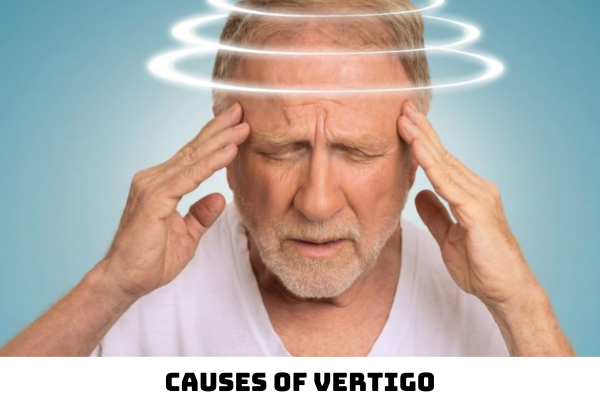Vietnam: What is the concept of vertigo? What are the causes of vertigo?
What is vertigo in Vietnam?
Pursuant to the provisions of the Guidelines issued together with Decision 5643/QD-BYT in 2015, the concept of vertigo is clearly stated as follows:
- Vertigo is a completely opposite hallucination in terms of movement or posture of the person. The word vertigo refers to all those feelings of imbalance that are derived from the vestibular organ.
- Vertigo can manifest in the form of spinning sensations of the person himself surrounding objects, or both. When there is no rotation, patients often use the word unbalanced. The feeling of loss of balance is also a symptom that originates due to vestibular organ dysfunction for which the sensation of spinning is only a special manifestation of a feeling of loss of balance.

What are the causes of vertigo in Vietnam?
Pursuant to the provisions of the Guidelines issued together with Decision 5643/QD-BYT in 2015, the causes of vertigo in Vietnam are clearly stated as follows:
The causes of vertigo are divided into three groups:
(1) Due to labyrinthine pathology
- Atrial jelly pathology
+ Benign paroxysmal vertigo.
+ Atrial hypoplasia.
- Vestibular intoxication
Due to drugs, aminozide antibiotics. Direct damage to the vestibular organ, and vestibular sensory cells with transferred hairs. Damage to the inner ear can also be indirectly caused by drugs that impair kidney function.
- Internal ear exotic fistula
+ Trauma: mainly due to stone bone fracture.
+ Spontaneous exotic fistula usually occurs in episodes with increased intra-ear intraimmune pressure.
+ Due to trauma to the vestibular pedal joint area such as replacing the pedal bone with an excessively long guide pillar.
+ After tuberculous atrial labyrinthitis, syphilis.
+ The sound stimulation is too strong.
+ Cholesteatoma.
- Metabolic diseases
+ Diuretics.
+ Generalized metabolic disorders cause increased blood lipids, causing increased intravascular fibrosis supplying blood to the vestibular.
+ Alcohol.
- Otitis
+ Chronic otitis: causes serous atrial anesthesia, acute atrial labyredness, and chronic atrial labyrinthitis.
+ Acute otitis media: causes serous atrial labyrinthitis, destructive atrial labyrinthitis.
+ Serous otitis: causes a disorder of middle ear pressure that changes the pressure between the two round and oval windows.
+ Otitis media cholesteatoma: causes acute atrial anesthesia and chronic atrial labyrinthitis accompanied by atrial fistula.
+ Tuberculous otitis.
+ Wegener's disease.
+ After ear surgery: may be caused by atrial fistula, atrial labyrinthitis, or tympanic tube ventilation disorders.
- Sclerofoam disease
- Pedal-pedal joint loose disease
+ Tulio phenomenon: Tulio classics, Tulio atrium.
+ Hennebert phenomenon
+ Syndrome of pedal bone hypermobility.
- Ménière syndrome
(2) Due to post-labyrinth causes
- Vestibular neuritis: the cause is now thought to be retrograde inflammation by viruses
- Cord Tumor VIII: starting with vestibular symptoms followed by gradual hearing loss accompanied by high-negative tinnitus due to compression of the cochlear nerve.
- Cerebellar angular tumor: meningioma, aneurysm, cyst ..
(3) Due to causes in the vestibular center of the cerebral cortex and on the cerebral bulb
Cerebrovascular pathologies
- Insufficiency of spinal artery circulation - basal trunk: is a common cause of vertigo symptoms in people over 50 years old due to labyrinthine anemia or ischemia of the brain stem. Symptoms include: hallucinations or unclear vision, double vision, decreased muscle tone, and speech disorders. These symptoms may be present with an episode of vertigo or isolation; caused by subclavian atherosclerosis or basal trunk spine.
- Wallenberg's syndrome: due to occlusion of the vertebral artery leading to ischemia or infarction in the lateral corner of the brain, post-filling causing damage to the middle and lower vestibular nuclei.
Pathology of brain tumors
- Cerebellar tumor or cerebellar abscess
- Cerebral glomerular neoplasms
- Quaternary brain tubercle tumor
- Tumor on cerebellar tent
Central nervous system diseases
- Multiple sclerosis
- Cerebral hollow disease
- Tabès disease
- Heirloom ataxia
What are the institutions for treatment of vertigo in Vietnam?
Pursuant to the provisions of the Guidelines issued together with Decision 5643/QD-BYT in 2015, the institutions for treatment of vertigo in Vietnam are specified as follows:
(1) Medical treatment
Treatment of acute vertigo attacks
The patient is placed in a quiet dark room, avoiding movements, and psychological stimuli.
- Medicine: hypertonic sweet serum.
- Antiemetic: atropine, metoclopramide, dimenhydrinate ..
- Anti-vertigo medication: tanganil..
- Sedatives: seduxen.
Treatment to stop paroxysmal vertigo:
- Avoid psychomotor stimuli, moving the patient, sudden change of posture, noisy places with lots of light, avoid cold showers.
- Diet: avoid eating chocolate, sausages, sausages, main noodles, avoid alcohol, Coca-Cola, and coffee.
- Drugs: diuretic, tanakan, duxil, cinarizin, serc, antihistamine, steroid, sedative, aspirin...
(2) Treatment by causes
Depending on the cause of vertigo, choose the appropriate treatment.
Treatment of benign paroxysmal vertigo: conservative treatment involves lying down to return the eardrum to its original position or surgical occlusion of the posterior semi-annular canal to prevent the eardrum from falling into this area (if conservative treatment does not work).
Treatment of the cause of intoxication: immediate cessation of the causative agent of intoxication, hypertonic sweet serum (Glucose 30%) intravenous infusion. Use of steroidal, diuretic, cytorestorative, vestibular neurotrophic drugs (Nevramin, B1, B12 in high doses).
Traumatic inner ear exotic fistula: surgical closure of the fistula.
Purulent inner otitis: vestibular destructive atrial anesthesia in combination with high-dose antibiotics.
Otitis media: surgical resolution of inflammatory accumulation combined with semi-annular tube fistula occlusion.
(3) Surgical treatment
- Cranial neurosurgery: aneurysms, vascular calcifications or cervical spondylosis causing compression of the vertebral arteries...
- Surgery in the scope of otolaryngology: treatment of Ménière's disease such as laparolytic sac opening, vestibular nerve resection, atrial delirium destruction surgery, etc.
LawNet